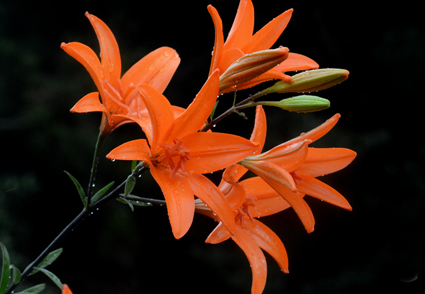Abstract
Lilium shenxianjuense, a new species of Liliaceae from Zhejiang, China, is described with illustrations. Phylogenetic analysis based on complete plastomes places the new species as sister to a clade that comprises species of L. sect. Sinomartagon. Morphologically, L. shenxianjuense is like L. concolor and L. lancifolium, but differs in habitat preferences and morphology. The plastome is like those of other species of Lilium in gene content and structure. The new species is critically endangered and in need of urgent protection.
References
- Baranova, M.V. (1988) A synopsis of the system of the genus Lilium (Liliaceae). Botanicheskii Zhurnal 73: 1319–1329.
- Boissier, P.E. (1882) Flora orientalis. George, Geneva & Basil, 190 pp.
- Chen, Z.H., Ma, D.D., Li, G.Y. & Fu, X.Q. (2016) New species of Lamiaceae from Zhejiang. Journal of Zhejiang Forestry Science and Technology 36: 83–86. http://doi.org/10.3969/j.issn.1001-3776.2016.06.015
- Comber, H.F. (1949) A new classification of the genus Lilium. In: Chittenden, F.J. (Ed.) Royal Horticultural Society Lily Year Book. Roal Horticultural Society, London, pp. 85–105.
- Du, Y.P., Bi, Y., Yang, F.P., Zhang, M.F., Chen, X.Q., Xue, J. & Zhang, X.H. (2017) Complete chloroplast genome sequences of Lilium: insights into evolutionary dynamics and phylogenetic analyses. Scientific reports 7: 5751. http://doi.org/10.1038/s41598-017-06210-2
- Gao, Y.D., Hohenegger, M., Harris, A., Zhou, S.D., He, X.J. & Wan, J. (2012) A new species in the genus Nomocharis Franchet (Liliaceae): evidence that brings the genus Nomocharis into Lilium. Plant Systematics and Evolution 298: 69–85. https://doi.org/10.1007/s00606-011-0524-1
- Gong, X., Hung, K.H., Ting, Y.W., Hsu, T.W., Malikova, L., Tran, H.T., Huang, C.L., Liu, S.H. & Chiang, T.Z. (2017) Frequent gene flow blurred taxonomic boundaries of sections in Lilium L. (Liliaceae). PLoS One 12: e0183209. https://doi.org/10.1371/journal.pone.0183209
- IUCN Standards and Petitions Committee (2022) Guidelines for using the IUCN red list categories and criteria, version 15. Prepared by the Standards and Petitions Committee. Available from: https://www.iucnredlist.org/documents/RedListGuidelines.pdf (accessed: 28 December 2023).
- Jin, J.J., Yu, W.B., Yang, J.B., Song, Y., DePamphilis, C.W., Yi, T.S. & Li, D.Z. (2020) GetOrganelle: a fast and versatile toolkit for accurate de novo assembly of organelle genomes. Genome Biology 21: 241. https://doi.org/10.1186/s13059-020-02154-5
- Katoh, K., Misawa, K., Kuma, K.I. & Miyata, T. (2002) MAFFT: a novel method for rapid multiple sequence alignment based on fast Fourier transform. Nucleic Acids research 30: 3059–3066. https://doi.org/10.1093/nar/gkf436
- Kearse, M., Moir, R., Wilson, A., Stones-Havas, S., Cheung, M., Sturrock, S., Buxton, S., Cooper, A., Markowitz, S., Duran, C., Thierer, T., Ashton, B., Meintjes, P. & Drummond, A. (2012) Geneious Basic: an integrated and extendable desktop software platform for the organization and analysis of sequence data. Bioinformatics 28: 1647–1649. https://doi.org/10.1093/bioinformatics/bts199
- Kim, H.T., Lim, K.B. & Kim, J.S. (2019) New insights on Lilium phylogeny based on a comparative phylogenomic study using complete plastome sequences. Plants 8: 547. https://doi.org/10.3390/plants8120547
- Li, J., Cai, J., Qin, H.H., Price, M., Zhang, Z., Yu, Y., Xie, D.F., He, X.J., Zhou, S.D. & Gao, X.F. (2022) Phylogeny, age, and evolution of tribe Lilieae (Liliaceae) based on whole plastid genomes. Frontiers in Plant Science 12: 699226. https://doi.org/10.3389/fpls.2021.699226
- Liang, S.Y. (1980) The genus Lilium L. In: Wang, F.-Z. & Tang, J. (Eds.) Flora Reipublicae Popularis Sinicae. Science Press, Beijing, pp. 116–157.
- Liang, S. & Tamura, M.N. (2000) Lilium L. In: Wu, Z.Y. & Raven, P.H. (Eds.) Flora of China. Science Press & Missouri Botanical Garden Press, Beijing & St. Louis, pp. 135–159.
- Lin, Q. (1993) Flora of Zhejiang. Zhejiang Science and Technology Publishing House, Hangzhou, 435 pp.
- Lindley, J. (1846) The vegetable kingdom. Bradbury & Evans, London, 205 pp.
- Linnaeus, C. (1753) Species plantarum. Salvius, Stockholm, 302 pp.
- Lou, M.X., Lu, Y.F., Sun, W.Y., Geng, X. & Jin, X.F. (2018) Rhamnus crenata var. xianjuensis, a new variety of Rhamnaceae from Zhejiang. Journal of Hangzhou Normal University (Natural Science Edition) 17: 250–255. http://doi.org/10.3969/j.issn.1674-232X.2018.03.005
- Lu, Y.F., Xie, W.Y., Chen, J.M., Ma, D.D. & Jin, X.F. (2017) Aster xianjuensis (Asteraceae, Astereae), a new species from Zhejiang. Journal of Hangzhou Normal University (Natural Science Edition) 16: 1–5. http://doi.org/10.3969/j.issn.1674-232X.2017.01.001
- Lu, R.S., Yang, T., Chen, Y., Wang, S.Y., Cai, M.Q., Cameron, K.M., Li, P. & Fu, C.X. (2021) Comparative plastome genomics and phylogenetic analyses of Liliaceae. Botanical Journal of the Linnean Society 196: 279–293. https://doi.org/10.1093/botlinnean/boaa109
- Ma, D.D., Chen, Z.H., Li, G.Y., Zhu, Z.M., Zhang, R.Z. & Peng, J.L. (2014) Tricyrtis xianjuensis (Liliaceae), a new species from eastern China. Annales Botanici Fennici 51: 217–221.
- Minh, B.Q., Hahn, M.W. & Lanfear, R. (2020) New methods to calculate concordance factors for phylogenomic datasets. Molecular Biology and Evolution 37: 2727–2733. https://doi.org/10.1093/molbev/msaa106
- Qu, X.J., Moore, M.J., Li, D.Z. & Yi, T.S. (2019) PGA: a software package for rapid, accurate, and flexible batch annotation of plastomes. Plant Methods 15: 50. https://doi.org/10.1186/s13007-019-0435-7
- Rafinesque, C.S. (1818) Clintonia Rafinesque. American Monthly Magazine and Critical Review 2: 266.
- Rong, L.P. & Lei, J.J. & Wang, C. (2011) Collection and evaluation of the genus Lilium resources in Northeast China. Genetic Resources and Crop Evolution 58: 115–123. https://doi.org/10.1007/s10722-010-9584-2
- Salisbury, R.A. (1806) On the characters of a distinct genus hitherto confounded with Ornithogalum, called Gagea; with some remarks on the importance of the inflorescence in distinguishing genera. Annals of Botany (König & Sims) 2: 553–557.
- Salisbury, R.A. (1806) Lilium concolor Salisbury. The Paradisus Londinensis 1: 47.
- Thunberg, C.P. (1794) Botanical observations on the Flora Japonica. Transactions of the Linnean Society of London 2: 326–342.
- Wilson, E.H. (1925) The lilies of eastern Asia: a monograph. Dulau, London, 355 pp.
- Woodcock, H.B.D. & Stearn, W.T. (1950) Lilies of the world: their cultivation and classification. Country Life, London, 431 pp.
- Zhou, N., Miao, K., Liu, C., Jia, L., Hu, J., Huang, Y. & Ji, Y. (2023) Historical biogeography and evolutionary diversification of Lilium (Liliaceae): new insights from plastome phylogenomics. Plant Diversity. https://doi.org/10.1016/j.pld.2023.07.009


